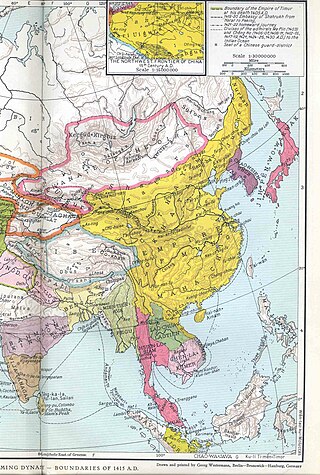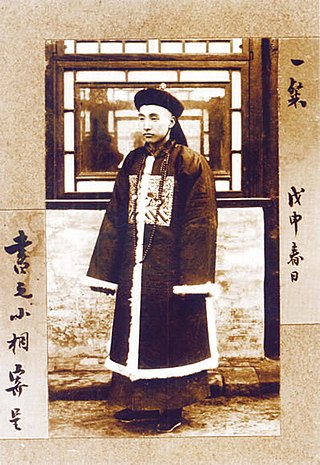
The Qing dynasty, officially the Great Qing, was a Manchu-led imperial dynasty of China and the last imperial dynasty in Chinese history. The dynasty, proclaimed in Shenyang in 1636, seized control of Beijing in 1644, which is considered the start of the dynasty's rule. The dynasty lasted until 1912, when it was overthrown in the Xinhai Revolution. In Chinese historiography, the Qing dynasty was preceded by the Ming dynasty and succeeded by the Republic of China. The multi-ethnic Qing dynasty assembled the territorial base for modern China. It was the largest imperial dynasty in the history of China and in 1790 the fourth-largest empire in world history in terms of territorial size. With over 426 million citizens in 1907, it was the most populous country in the world at the time.

The Ming dynasty, officially the Great Ming, was an imperial dynasty of China, ruling from 1368 to 1644 following the collapse of the Mongol-led Yuan dynasty. The Ming dynasty was the last imperial dynasty of China ruled by the Han people, the majority ethnic group in China. Although the primary capital of Beijing fell in 1644 to a rebellion led by Li Zicheng, numerous rump regimes ruled by remnants of the Ming imperial family—collectively called the Southern Ming—survived until 1662.

The Yonghe Temple, also known as the Yonghe Lamasery, or popularly as the Lama Temple, is a temple and monastery of the Gelug school of Tibetan Buddhism located on 12 Yonghegong Street, Dongcheng District, Beijing, China. The building and artwork of the temple is a combination of Han Chinese and Tibetan styles. This building is one of the largest Tibetan Buddhist monasteries in China proper. The current abbot is Lama Hu Xuefeng. Yonghe Temple was the highest Buddhist temple in the country during the middle and late Qing dynasty.

The Zongli Yamen, short for Office for the General Management of Affairs Concerning the Various Countries (總理各國事務衙門), also known as Prime Minister's Office, Office of General Management, was the government body in charge of foreign policy in imperial China during the late Qing dynasty. It was established by Prince Gong on 11 March 1861 after the Convention of Beijing. It was abolished by the Qing government in 1901 and replaced with a Foreign Office of ministry rank.

Religion in Taiwan is characterised by a diversity of religious beliefs and practices, predominantly those pertaining to the continued preservation of the ancient Chinese culture and religion. Freedom of religion is inscribed in the constitution of the Republic of China (Taiwan). The majority of Taiwanese people practice a combination of Buddhism and Taoism often with a Confucian worldview, which is collectively termed as Chinese folk religion.
The Lifan Yuan was an agency in the government of the Qing dynasty of China which administered the empire's Inner Asian territories such as Mongolia and oversaw the appointments of Ambans in Tibet. Until the 1860s, it was also responsible for the Qing's relations with the Russian Empire.
This is a list of topics related to Tibet.

The Mongolian and Tibetan Affairs Commission (MTAC) was a ministry-level commission of the Executive Yuan in the Republic of China. It was disbanded on 15 September 2017.
The Three Departments and Six Ministries system was the primary administrative structure in imperial China from the Sui dynasty (581–618) to the Yuan dynasty (1271–1368). It was also used by Balhae (698–926) and Goryeo (918–1392) and various other kingdoms in Manchuria, Korea and Vietnam.

The following outline is provided as an overview of and topical guide to Tibet:

The Ming dynasty considered Tibet to be part of the Western Regions. While the Ming dynasty at its height had some degree of influence in Tibet, the exact nature of their relations is under dispute by modern scholars. Analysis of the relationship is further complicated by modern political conflicts and the application of Westphalian sovereignty to a time when the concept did not exist. The Historical Status of China's Tibet, a book published by the People's Republic of China, asserts that the Ming dynasty had unquestioned sovereignty over Tibet by pointing to the Ming court's issuing of various titles to Tibetan leaders, Tibetans' full acceptance of the titles, and a renewal process for successors of these titles that involved traveling to the Ming capital. Scholars in China also argue that Tibet has been an integral part of China since the 13th century and so it was a part of the Ming Empire. However, most scholars outside China, such as Turrell V. Wylie, Melvyn C. Goldstein, and Helmut Hoffman, say that the relationship was one of suzerainty, Ming titles were only nominal, Tibet remained an independent region outside Ming control, and it simply paid tribute until the Jiajing Emperor, who ceased relations with Tibet.

The Kashag was the governing council of Tibet during the rule of the Qing dynasty and post-Qing period until the 1950s. It was created in 1721, and set by Qianlong Emperor in 1751 for the Ganden Phodrang in the 13-Article Ordinance for the More Effective Governing of Tibet. In that year the Tibetan government was reorganized after the riots in Lhasa of the previous year. The civil administration was represented by the Council (Kashag) after the post of Desi was abolished by the Qing imperial court. The Qing imperial court wanted the 7th Dalai Lama to hold both religious and administrative rule, while strengthening the position of the High Commissioners.

The Tibet Area was a province-level administrative division of China in the 20th century. It was de jure created after the establishment of the Republic of China in 1912, and nominally includes the Ü-Tsang and Ngari areas, but not the Amdo and Kham areas. The territories were merely claimed by the ROC, but actually controlled by an independent Tibet with a government headed by the Dalai Lama in Lhasa. At this time, the scope of de facto independent Tibet included the "Tibet area" and the Chamdo area west of the Jinsha River, which claimed by China. The ROC retreated to Taiwan and lost control of mainland China to the People's Republic of China (PRC) in 1949; afterwards, the ROC continued to claim Tibet.
Shamanism was the dominant religion of the Jurchen people of northeast Asia and of their descendants, the Manchu people. As early as the Jin dynasty (1115–1234), the Jurchens conducted shamanic ceremonies at shrines called tangse. There were two kinds of shamans: those who entered in a trance and let themselves be possessed by the spirits, and those who conducted regular sacrifices to heaven, to a clan's ancestors, or to the clan's protective spirits.

Chinese Esoteric Buddhism refers to traditions of Tantra and Esoteric Buddhism that have flourished among the Chinese people. The Tantric masters Śubhakarasiṃha, Vajrabodhi and Amoghavajra, established the Esoteric Buddhist Zhenyan tradition from 716 to 720 during the reign of Emperor Xuanzong of Tang. It employed mandalas, mantras, mudras, abhiṣekas, and deity yoga. The Zhenyan tradition was transported to Japan as Shingon Buddhism by Kūkai as well as influencing Korean Buddhism and Vietnamese Buddhism. The Song dynasty (960–1279) saw a second diffusion of Esoteric texts. Esoteric Buddhist practices continued to have an influence into the late imperial period and Tibetan Buddhism was also influential during the Yuan dynasty period and beyond. In the Ming dynasty (1368–1644) through to the modern period, esoteric practices and teachings became absorbed and merged with the other Chinese Buddhist traditions to a large extent.

The Ganden Phodrang or Ganden Podrang was the Tibetan system of government established by the 5th Dalai Lama in 1642, when the Oirat lord Güshi Khan who founded the Khoshut Khanate conferred all spiritual and political power in Tibet to him in a ceremony in Shigatse. During the ceremony, the Dalai Lama "made a proclamation declaring that Lhasa would be the capital of Tibet and the government of would be known as Gaden Phodrang" which eventually became the seat of the Gelug school's leadership authority. The Dalai Lama chose the name of his monastic residence at Drepung Monastery for the new Tibetan government's name: Ganden (དགའ་ལྡན), the Tibetan name for Tushita heaven, which, according to Buddhist cosmology, is where the future Buddha Maitreya resides; and Phodrang (ཕོ་བྲང), a palace, hall, or dwelling. Lhasa's Red Fort again became the capital building of Tibet, and the Ganden Phodrang operated there and adjacent to the Potala Palace until 1959.

Tibet under Qing rule refers to the Qing dynasty's rule over Tibet from 1720 to 1912. The Qing rulers incorporated Tibet into the empire along with other Inner Asia territories, although the actual extent of the Qing dynasty's control over Tibet during this period has been the subject of political debate. The Qing called Tibet a fanbu, fanbang or fanshu, which has usually been translated as "vassal", "vassal state", or "borderlands", along with areas like Xinjiang and Mongolia. Like the preceding Yuan dynasty, the Manchus of the Qing dynasty exerted military and administrative control over Tibet, while granting it a degree of political autonomy.

The Bureau of Buddhist and Tibetan Affairs, or Xuanzheng Yuan was a government agency of the Mongol-led Yuan dynasty of China to handle Buddhist affairs across the empire in addition to managing the territory of Tibet. It was originally set up by Kublai Khan in 1264 under the name Zongzhi Yuan or the "Bureau of General Regulation", before it was renamed in 1288.
The Ministry of Ceremonies was one of the nine ministries of the Chinese Han dynasty. The Minister of Ceremonies, also known as Grand Master of Ceremonies, was the chief official in charge of religious rites, rituals, prayers, and the maintenance of ancestral temples and altars. The role's title was changed to Upholder of Ceremonies from 195 to 144 BC before reverting to the original title. Although his main concern was to link the emperor with the supernatural world and Heaven, he was also given the task of setting educational standards for the Imperial University and the academic chairs who specialized in the Five Classics, the canon of Confucianism.

The Qing dynasty (1644–1912) was the last imperial dynasty of China. The early Qing emperors adopted the bureaucratic structures and institutions from the preceding Ming dynasty but split rule between the Han and Manchus with some positions also given to Mongols. Like previous dynasties, the Qing recruited officials via the imperial examination system until the system was abolished in 1905. The Qing divided the positions into civil and military positions, each having nine grades or ranks, each subdivided into a and b categories. Civil appointments ranged from an attendant to the emperor or a grand secretary in the Forbidden City (highest) to being a prefectural tax collector, deputy jail warden, deputy police commissioner, or tax examiner. Military appointments ranged from being a field marshal or chamberlain of the imperial bodyguard to a third class sergeant, corporal or a first or second class private.













